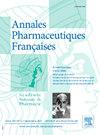盐酸阿莫罗芬载固体脂质纳米颗粒:制备、表征及体外甲渗透治疗甲癣的研究。
IF 1.1
Q4 PHARMACOLOGY & PHARMACY
引用次数: 0
摘要
甲真菌病是一种由真菌引起的甲板疾病,导致甲的进行性损伤。这种感染需要较长时间的口服和局部治疗。局部途径的治疗是困难的,因为药物在感染指甲的低可用性。这种局部治疗的失败是传统药物输送系统(DDS)的缺点,特别是药物穿过甲板的渗透问题。固体脂质纳米颗粒(SLN)方法被用来克服这些问题。采用微乳冷稀释法将盐酸阿莫罗芬(AOF)掺入SLN。以单链素和硬脂酸为固体脂质,制备载药sln。通过改变固体脂质和胆汁盐的类型,优化了纳米颗粒的配方。牛磺酸胆酸钠(STC)和牛磺酸胆酸钠(STG)是配方中用作生物表面活性剂的胆汁盐。以硬脂酸和STG为原料制备的sln包封效率为71.73%,载药效率为13.03%。胆汁盐影响颗粒大小范围,发现STG与硬脂酸(406 nm)产生的颗粒比STC更小。同时对工艺参数进行了优化,以403相对离心力(RCF)为最优,可制得较小粒径(406 nm)的颗粒。载aof - sln乳膏和市售乳膏(Amfocin)也进行了甲板药物渗透和抗真菌研究。sln提高了AOF的渗透性(1.63倍)和抗真菌活性(2.50倍)。透射电子显微镜(TEM)图像显示sln为球形,无聚集。结果表明,sln在冷藏条件下具有较高的稳定性。sln被掺入乳膏中,最终用于治疗甲癣。采用高效液相色谱法(HPLC)定量测定制剂中AOF的含量。本文章由计算机程序翻译,如有差异,请以英文原文为准。

Amorolfine hydrochloride loaded solid lipid nanoparticles: Preparation, characterization and ex vivo nail permeation study to treat onychomycosis
Onychomycosis is a disease of the nail plate caused by fungi, leading to the progressive defacing of the nail. The infection requires a longer period of treatment orally and topically. The treatment with the topical route is difficult due to the low availability of drugs across the infected nail. This failure in topical treatment is the drawback of the conventional drug delivery system (DDS), particularly drug penetration issues across the nail plate. The solid lipid nanoparticle (SLN) approach was used to overcome such issues. The drug amorolfine hydrochloride (AOF) was incorporated into SLN by using the micro-emulsion cold dilution method. Monostrearin and stearic acid were used as solid lipids in the formulation of drug-loaded SLNs. The nanoparticle formulation was optimized by varying the type of solid lipids and bile salts. Sodium taurocholate (STC) and sodium tauroglycholate (STG) are the bile salts used as biosurfactants in the formulation. The SLNs prepared with stearic acid and STG demonstrated higher drug encapsulation efficiency (71.73%) and drug loading efficiency (13.03%) than monostearin. Bile salts have affected the particle size range and STG was found to produce smaller size particles with stearic acid (406 nm) than STC. Process parameter homogenization speed was also optimized and 403 relative centrifugal force (RCF) was optimal to produce smaller-size particles (406 nm). The drug permeation through the nail plate and anti-fungal studies were also performed for AOF-SLNs loaded cream and marketed cream (Amfocin). The SLNs have improved the permeation (1.63-fold) and anti-fungal activity (2.50-fold) of AOF. Transmission electron microscopy (TEM) images revealed a spherical shape of SLNs with no aggregation. The physical stability was performed and SLNs have higher stability at refrigeration storage. The SLNs were incorporated in cream for the final application for onychomycosis. The analytical method of high-performance liquid chromatography (HPLC) was used for the quantification of AOF in the formulations.
L’onychomycose est une maladie de la plaque unguéale provoquée par des champignons, entraînant une dégradation progressive de l’ongle. L’infection nécessite une période de traitement plus longue par voie orale et topique. Le traitement par voie topique est difficile en raison de la faible disponibilité des médicaments au niveau de l’ongle infecté. Cet échec du traitement topique constitue l’inconvénient du système d’administration de médicaments conventionnel (DDS), en particulier les problèmes de pénétration du médicament à travers la plaque de l’ongle. L’approche des nanoparticules lipidiques solides (SLN) a été utilisée pour surmonter ces problèmes. Le chlorhydrate d’amorolfine (AOF) a été incorporé dans le SLN en utilisant la méthode de dilution à froid par microémulsion. La monostéarine et l’acide stéarique ont été utilisés comme lipides solides dans la formulation de SLN chargés de médicaments. La formulation des nanoparticules a été optimisée en faisant varier le type de lipides solides et de sels biliaires. Le taurocholate de sodium (STC) et le tauroglycholate de sodium (STG) sont les sels biliaires utilisés comme biosurfactants dans la formulation. Les SLN préparés avec de l’acide stéarique et du STG ont démontré une efficacité d’encapsulation du médicament (71,73 %) et une efficacité de chargement du médicament (13,03 %) supérieures à celles de la monostéarine. Les sels biliaires ont affecté la plage granulométrique et le STG s’est avéré produire des particules de plus petite taille avec l’acide stéarique (406 nm) que le STC. La vitesse d’homogénéisation des paramètres de processus a également été optimisée et la force centrifuge relative (RCF) de 403 était optimale pour produire des particules de plus petite taille (406 nm). La perméation du médicament à travers la plaque à ongles et des études antifongiques ont également été réalisées pour la crème chargée en AOF-SLN et la crème commercialisée (Amfocin). Les SLN ont amélioré la perméation (1,63 fois) et l’activité antifongique (2,50 fois) de l’AOF. Les images de microscopie électronique à transmission (TEM) ont révélé une forme sphérique de SLN sans agrégation. La stabilité physique a été réalisée et les SLN ont une stabilité plus élevée lors du stockage réfrigéré. Les SLN ont été incorporés dans une crème pour l’application finale pour l’onychomycose. La méthode analytique de chromatographie liquide haute performance (HPLC) a été utilisée pour la quantification de l’AOF dans les formulations.
求助全文
通过发布文献求助,成功后即可免费获取论文全文。
去求助
来源期刊

Annales pharmaceutiques francaises
PHARMACOLOGY & PHARMACY-
CiteScore
1.70
自引率
7.70%
发文量
98
期刊介绍:
This journal proposes a scientific information validated and indexed to be informed about the last research works in all the domains interesting the pharmacy. The original works, general reviews, the focusing, the brief notes, subjected by the best academics and the professionals, propose a synthetic approach of the last progress accomplished in the concerned sectors. The thematic Sessions and the – life of the Academy – resume the communications which, presented in front of the national Academy of pharmacy, are in the heart of the current events.
 求助内容:
求助内容: 应助结果提醒方式:
应助结果提醒方式:


